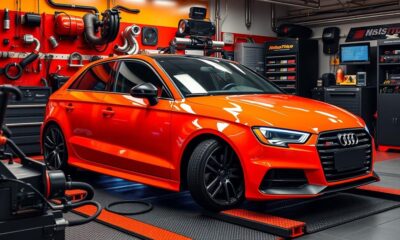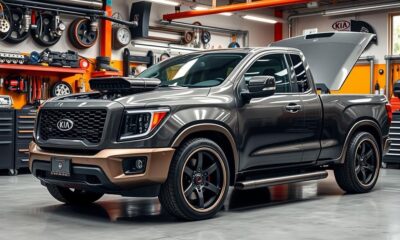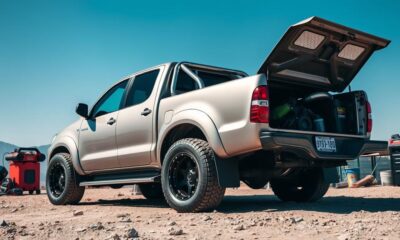Automotive DIY and Professional Guides
How to Get a Car Tune-Up: What to Expect and How to Prepare
What you need to know before your car tune-up could save you time and money—discover the essential steps to prepare effectively.

Getting a car tune-up is essential for maintaining your vehicle's performance. First, gather your vehicle's service manual and any previous maintenance records. You should note any specific issues like strange noises or warning lights. During the appointment, expect services like replacing spark plugs, changing fluids, and inspecting belts. Mechanics will provide a detailed report on work done and future maintenance suggestions. Regular tune-ups can enhance fuel efficiency and prevent costly repairs down the line. Stay tuned for more details on what services you might need and how to maximize your vehicle's performance. To ensure your vehicle runs smoothly, it’s important to follow regular car maintenance tips. This includes checking tire pressure, monitoring oil levels, and scheduling regular inspections. By staying on top of these routine tasks, you can extend the life of your car and avoid unexpected breakdowns. Remember, a well-maintained car is a safer and more reliable one.
Key Takeaways
- Regular tune-ups enhance engine performance, fuel efficiency, and vehicle longevity by addressing minor issues before they escalate into costly repairs.
- Gather your vehicle's service manual, maintenance records, and document any performance concerns for discussion with the technician.
- Expect services like spark plug replacement, fluid changes, and inspection of belts and hoses to ensure optimal engine functionality.
- Prepare for a detailed service report summarizing the work done and future maintenance recommendations for your vehicle.
- Schedule tune-ups every 30,000 to 100,000 miles, depending on your vehicle's needs, to maintain peak performance and efficiency.
Understanding Tune-Ups
When it comes to keeping your car running smoothly, understanding tune-ups is crucial. A tune-up involves routine maintenance tasks designed to enhance engine performance and longevity. This typically includes replacing spark plugs, ignition wires, and filters. Regular tune-ups help prevent minor issues from becoming major repairs, ultimately improving fuel efficiency and your overall driving experience.
The frequency of tune-ups varies based on your vehicle make, model, age, and the manufacturer's recommended maintenance schedule. Generally, you should consider a tune-up every 30,000 to 100,000 miles. During a tune-up, key components like the ignition system, air filters, and fuel filters are inspected to verify they're functioning effectively.
Modern vehicles often utilize advanced technology, so tune-up procedures might differ from traditional practices. Nowadays, the focus is more on inspections rather than just component replacements.
Keeping up with these inspections and adhering to your maintenance schedule will greatly boost your car's performance efficiency. By understanding the importance of tune-ups, you're taking a proactive step in maintaining your vehicle and ensuring it runs at its best for years to come.
Key Components to Inspect
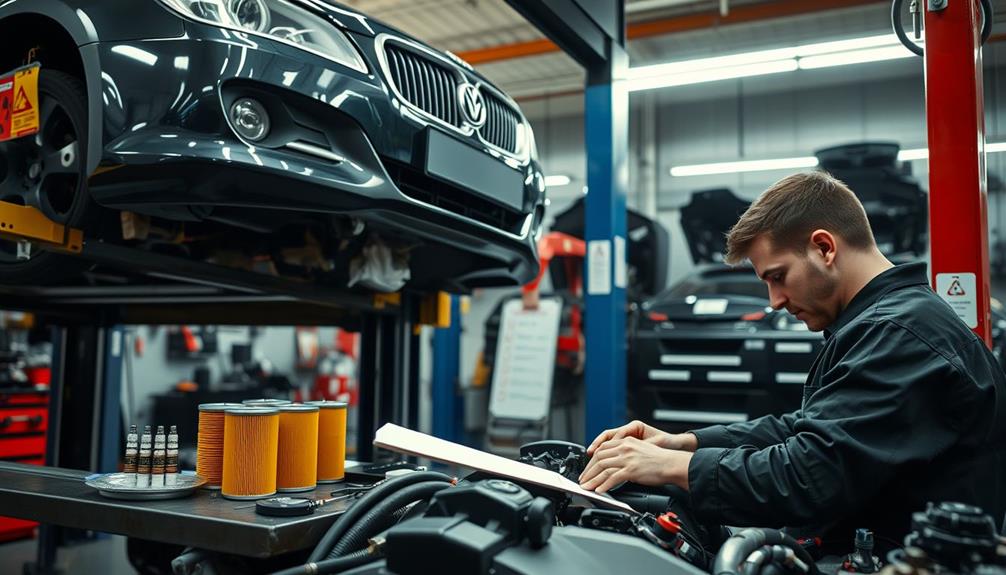
A thorough inspection of key components during a car tune-up is crucial for maintaining peak performance and preventing costly repairs. Here's what you should focus on:
| Component | Maintenance Tips |
|---|---|
| Spark Plugs | Replace if worn or misfiring (60,000-120,000 miles). |
| Ignition Wires | Check for fraying; faulty wires affect performance and fuel efficiency. |
| Air Filters | Replace every 15,000 miles for ideal airflow and engine performance. |
| Belts and Hoses | Inspect for cracks or leaks; replace timing belts every 80,000-100,000 miles. |
| Essential Fluids | Verify engine oil, brake fluid, and coolant are at proper levels and free from contamination. |
Importance of Regular Maintenance

Regular maintenance isn't just about keeping your car running; it's essential for enhancing engine performance and ensuring your vehicle lasts longer.
By staying on top of tune-ups and routine checks, you can save money in the long run by preventing costly repairs and improving fuel efficiency.
Don't overlook the importance of keeping your car in top shape to enjoy a smoother, safer ride.
Engine Performance Enhancement
Engine performance enhancement hinges on the importance of regular maintenance. By keeping up with routine tune-ups, you can markedly boost your vehicle's efficiency and responsiveness.
Here are three key areas to focus on:
- Ignition System: Replacing spark plugs and ignition wires as recommended prevents misfires, guaranteeing peak engine performance and improved fuel efficiency.
- Filters: Maintaining clean air and fuel filters is essential. Contaminants can hinder engine performance, leading to sluggish acceleration and increased fuel consumption.
- Fluid Changes: Regularly changing motor oil and coolant can prevent excessive wear on engine components. This not only extends your vehicle's lifespan but also enhances overall performance.
During a tune-up, mechanics will adjust ignition timing, inspect belts and hoses, and perform necessary fluid changes. These steps are vital for preventing overheating and potential engine failure.
A well-maintained engine runs smoother, accelerates better, and delivers a more enjoyable driving experience. By prioritizing regular maintenance, you'll guarantee your vehicle operates at its best, ultimately saving you time and money in the long run.
Cost-Effective Preventative Care
Keeping your vehicle in top shape not only enhances performance but also saves you money in the long run. Regular preventative maintenance, like spark plug replacement and air filter changes, can boost your engine performance and fuel efficiency by up to 10%. This means fewer trips to the gas station and lower fuel costs over time.
When you follow manufacturer-recommended maintenance schedules, you can prevent minor issues from escalating into major repairs, potentially saving you an average of $1,200 annually.
Ignoring routine maintenance can lead to engine misfires and a significant drop in power, potentially decreasing fuel efficiency by 25%. Regular fluid changes and filter replacements, typically needed every 15,000 to 30,000 miles, are essential for maintaining vehicle health and preventing extensive engine wear.
Longevity of Vehicle Components
When you prioritize maintenance, you can greatly extend the lifespan of your vehicle's components. Regular tune-ups and inspections keep your car running smoothly, preventing costly repairs down the line.
Here are three key areas to focus on:
- Spark Plugs: Replace them every 60,000 to 120,000 miles. Old spark plugs can cause misfires, leading to engine damage and reduced performance.
- Fluid Levels: Regularly check and maintain fluid levels, including oil, brake fluid, and coolant. Changing engine oil every 3,000 to 7,500 miles helps keep your engine lubricated and reduces wear, enhancing overall longevity.
- Air Filters and Timing Belts: Change air filters every 15,000 miles to guarantee peak airflow and prevent contaminants from damaging your engine. Timing belts should be replaced every 80,000 to 100,000 miles to avoid catastrophic engine failure.
Preparing for Your Appointment
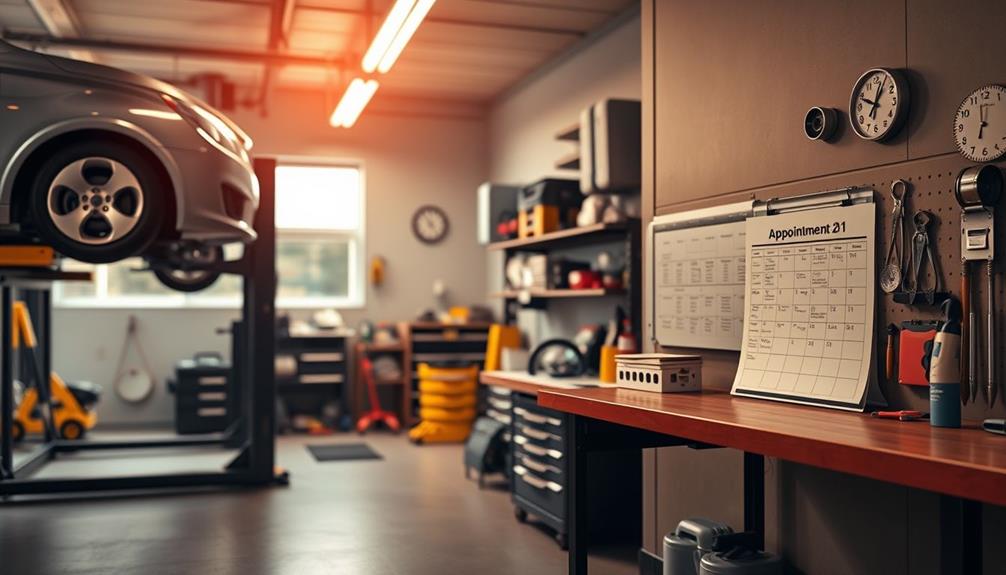
Before your appointment, gather your vehicle's service manual to check the recommended maintenance schedule.
It's also smart to note any specific concerns you've noticed, like strange noises or poor acceleration.
This info will help your technician address your vehicle's needs more effectively.
Gather Vehicle Information
Gathering your vehicle information is vital for a successful tune-up appointment. Before you head to the shop, make certain you've got all the necessary details at your fingertips. This not only helps the technician but also guarantees you get the best service.
Here's what to gather:
- Make, Model, and Year: Knowing these details will help the technician understand the specific needs of your vehicle.
- Current Mileage: This number is essential for determining the appropriate maintenance schedule.
- Owner's Manual and Service Records: Review your manual for maintenance schedules and any previous service history.
Additionally, be aware of any symptoms your vehicle has shown, such as engine misfires, rough idling, or warning lights on the dashboard. Jot these down to discuss during your appointment.
Also, if applicable, check for any manufacturer recalls or service bulletins related to your vehicle.
List Maintenance Concerns
It's important to list any maintenance concerns you have about your vehicle as you prepare for your appointment. This guarantees you and your technician can address all issues effectively. Here's a handy table to help you organize your thoughts:
| Concern | Description | Action Needed |
|---|---|---|
| Dashboard Warning Lights | Check for any illuminated lights | Discuss with technician |
| Unusual Noises | Listen for strange sounds | Mention specifics |
| Performance Issues | Note changes in fuel efficiency | Review maintenance schedule |
Before your tune-up, inspect for any unusual noises, rough idling, or difficulty starting, as these can indicate issues with engine components like spark plugs and wires/coil. Also, review your owner's manual for the maintenance schedule to guarantee you're covering necessary tune-up services.
Document any previous maintenance performed, as this will help the technician tailor their services to your vehicle's history. Prepare a list of recent performance changes, such as decreased fuel efficiency or stalling, to discuss during your appointment. Being organized will make the process smoother and more effective.
What to Expect During Service
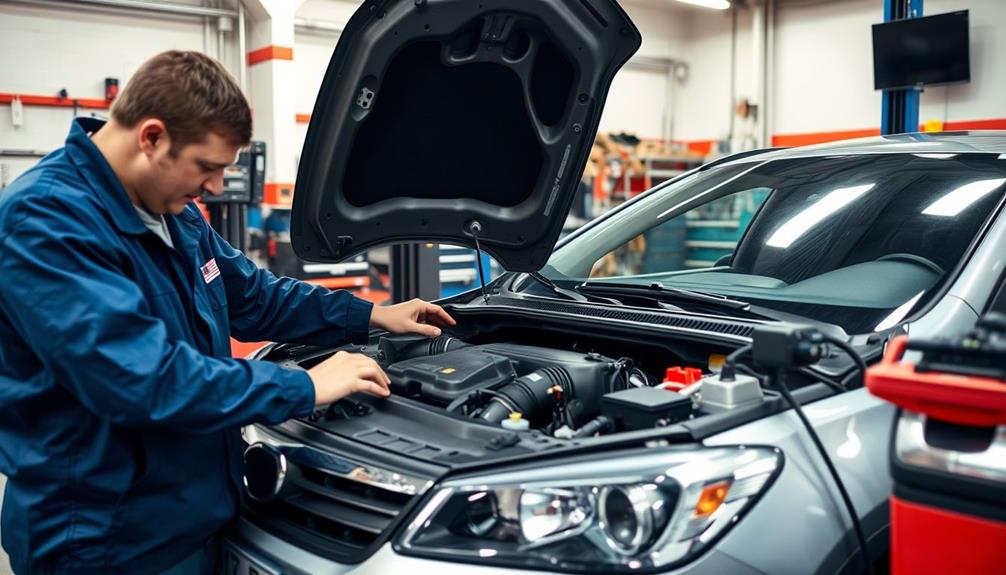
During a car tune-up, you can expect technicians to replace vital components like spark plugs, ignition wires, and air filters, all of which boost engine performance and fuel efficiency.
A thorough inspection of the ignition system is also standard practice. This includes checking timing and cleaning components like the throttle body.
Here's what you can anticipate during service:
- Fluid Changes: Expect changes to important fluids, such as engine oil, coolant, and brake fluid, to guarantee peak vehicle health and performance.
- Wear Assessment: Technicians will assess belts and hoses for signs of wear, which is essential to prevent potential engine damage.
- Service Report: After the tune-up, you'll receive a detailed service report summarizing the work done and offering maintenance recommendations based on your vehicle's specific needs.
Common Tune-Up Services Offered

A car tune-up typically includes several essential services designed to enhance your vehicle's performance and longevity. One of the first tasks is the replacement of spark plugs and ignition wires, which are vital for peak engine performance and can greatly improve fuel efficiency.
You'll also see technician services like engine air filter and fuel filter replacements, guaranteeing clean airflow and fuel delivery to your engine.
Another common service is throttle body cleaning, which removes carbon buildup and boosts engine responsiveness and efficiency. If your vehicle has higher mileage, you might benefit from fuel system cleaning. This service maintains injector cleanliness, helping to keep overall engine performance in check.
Additionally, technicians may adjust ignition timing during a tune-up. This adjustment aligns with manufacturer specifications and verifies your engine runs smoothly and efficiently.
All of these services are part of routine maintenance, aiming to keep your vehicle in top shape. By addressing these components, you're setting the stage for enhanced engine performance and peak efficiency, making your ride more enjoyable and reliable.
Recognizing Signs of Trouble

Recognizing the signs that your car needs a tune-up can save you from more significant problems down the road. Keep an eye out for these critical indicators:
- Engine Misfires and Rough Idling: If you notice engine misfires or your vehicle's engine is idling roughly, it could signal worn spark plugs or ignition components that need replacing.
- Check Engine Light: If your check engine light illuminates, don't ignore it. This warning can indicate various issues, including problems related to ignition or fuel delivery, often requiring a tune-up.
- Performance Issues: Difficulty starting your car, slow acceleration, or poor overall performance are clear signs something's amiss. Unusual engine noises, like knocking or pinging, may also suggest issues with fuel mixture or ignition timing.
Addressing these symptoms promptly can help maintain your vehicle's fuel efficiency and overall reliability.
If you experience any of these signs, scheduling a tune-up should be a priority to prevent further complications and guarantee smooth driving.
Maintaining Vehicle Performance
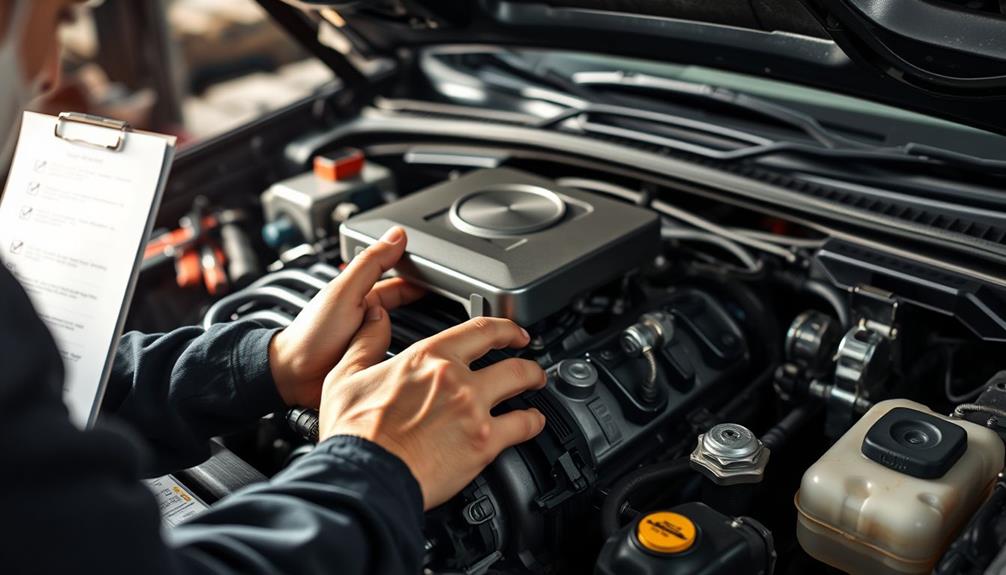
To keep your vehicle running at its best, regular maintenance is key. Routine inspections of spark plugs and ignition wires are essential. Worn spark plugs can cause misfires, markedly impacting your fuel efficiency. By replacing them promptly, you can enhance engine performance and potentially improve gas mileage by up to 10%.
Don't overlook your air filters, either. A dirty air filter restricts airflow, which can reduce engine performance and increase gas consumption by as much as 6-11%. Keeping them clean is critical for ideal vehicle operation.
Fluid changes, including engine oil and coolant, should be part of your regular maintenance routine. These changes prevent excessive wear and overheating, ensuring your vehicle runs smoothly over time.
Additionally, monitoring belts and hoses for signs of wear is imperative. A failed timing belt can lead to catastrophic engine damage, resulting in costly repairs.
Frequently Asked Questions
What Does a Car Tune up Include?
A car tune-up includes replacing spark plugs, ignition wires, and filters. You'll also have your throttle body cleaned, fuel system checked, and belts inspected. These steps enhance your engine's performance and overall vehicle efficiency.
What Is the Average Cost of a Full Tune-Up?
Think of a tune-up like a spa day for your car. On average, you'll spend between $100 and $300, depending on your vehicle's needs and whether you're opting for basic or extensive services.
What to Do Before Getting Car Tuned?
Before getting your car tuned, review the owner's manual for maintenance schedules, inspect spark plugs and fluids, note any symptoms, gather service records, and schedule your appointment when you can be without your vehicle for a few hours.
How Long Does a Tune-Up Usually Take?
Ever wondered how long a tune-up takes? Typically, it lasts between 1 to 3 hours. The exact time depends on your car's condition and the services needed, so check with your mechanic for specifics.
Conclusion
In the same way a musician tunes their instrument for a perfect performance, giving your car a tune-up guarantees it runs smoothly. Just like a guitar can sound off-key without proper adjustments, your vehicle can struggle without regular maintenance. By preparing for your appointment and understanding what to expect, you're setting the stage for a harmonious driving experience. So, treat your car to that tune-up—it'll thank you with better performance on every journey!
Jimmy is a dedicated drift and drag racing enthusiast who deeply understands the unique tuning requirements for these high-octane sports. His expertise covers everything from drift suspension setups to drag racing launch control systems, providing our readers with the knowledge they need to compete at the highest levels. Jimmy’s passion for these motorsports shines through in his detailed articles and practical recommendations.
Automotive DIY and Professional Guides
Future Projections for US Truck Market Trends
Explore the latest insights on what the future projections for the US truck market reveal. Get ahead of emerging trends and industry shifts.

Have you ever thought about the future of the trucking industry while driving on the freeway? Surrounded by trucks, carrying things we use every day, it’s a bustling world on wheels. The US truck market is at a turning point, ready for big changes. We are seeing shifts that will redefine the way we move goods and use technology. One major factor influencing the future of the trucking industry is the impact of interest rates. As interest rates fluctuate, so too does the cost of financing new equipment and expanding operations. This can directly affect the growth and profitability of trucking companies, leading to potential changes in industry dynamics and competition. Additionally, as technology continues to advance, there will be a growing emphasis on efficiency and sustainability in the trucking industry, further shaping its future.
With more people buying online, smarter tech, and strict environmental rules, the truck market is headed for change. This journey is not just about trucks. It’s about adapting to a constantly changing world, facing new challenges, and welcoming innovation. Let’s dive into these trends for insights into what they mean for us as consumers and key players in the economy.
Key Takeaways
- The US truck market is projected to grow at a rate of 4% annually over the next five years.
- Demand for electric trucks is expected to rise by 15% by the end of the upcoming quarter.
- Truck sales are estimated to reach 2.5 million units in the next fiscal year, reflecting a 7% growth.
- Leading truck manufacturers will invest 20% more in research for autonomous driving technology next year.
- The anticipated increase in freight tonnage by trucks in the US could reshape logistics dynamics by 2027.
Introduction to the US Truck Market Landscape
The trucking industry is key to the US economy. It boosts logistics and the supply chain. The US truck market is wide, helping different sectors by moving goods all over the country. This industry features big fleets, independent drivers, and lots of transport companies that keep commerce alive.
Different main players exist in trucking, like long-haul firms, local carriers, and specialized freight services. This mix creates a thriving competition, improving services and reducing costs. When you look into trucking, see how it helps with jobs and boosts the economy in many states.
The US truck market has several parts, including freight transport and logistics management. Each is crucial in getting goods to people and companies. Knowing how this market works helps those involved make better decisions and plans as trends and preferences change.
In short, trucking is vital to the US economy. It shows strength and flexibility when facing problems. Think about how technology, laws, and market needs influence this interesting landscape.
Current Trends Influencing the US Truck Market
The US truck market is changing a lot these days. This is because of two main things: e-commerce demand and new tech. The need for trucks is growing because more people are buying things online. So, truck companies are now very important for delivering all the stuff we order.
The Impact of E-commerce on Trucking Demand
Online shopping has made us want more things delivered to our homes. This need has grown a lot. Because of this, trucking companies have big chances to grow. They are expected to carry more stuff by P% next year. Businesses are trying new ways to get their products to us faster and cheaper.
Technological Advancements in Truck Manufacturing
New technology is changing how trucks are made. Things like automation and electric trucks are making a big difference. They help trucks run better and cleaner. Companies are spending $ABC million on new tech to meet tough air pollution rules. With tech like self-driving trucks, roads could become safer, reducing accidents by Q%.

What are the future projections for the US truck market
The US truck market is about to change a lot. Electric trucks are becoming more popular. By 2030, a lot of trucks on the road will be electric. This is because people want cleaner options and companies are investing in this tech.
Growth Opportunities in the Electric Truck Sector
Electric trucks are on the rise. This thanks to better batteries and more places to charge. By 2030, they will make up a big part of the market. Companies are switching to electric to save money and cut down on pollution.
Changes in Regulatory Standards and Their Effects
New rules are shaping the future of trucks. These rules make trucks cleaner and safer. Meeting these standards means making new kinds of trucks. Companies adapting to these changes will get benefits for using clean technology.
Insights on the Supply Chain and Logistics Dynamics
The way we move things around is linked to truck market trends. By 2025, expect more heavy-duty trucks needed for building things. Technology like software to manage fleets keeps truck makers ready for what’s next.

Influence of Economic Factors on Truck Sales
Economic factors are key to truck sales in the United States. Knowing how fuel prices and GDP growth affect sales is critical. This knowledge helps us understand buyer behavior and truck sales trends.
The Role of Fuel Prices in Consumer Choices
Fuel prices influence what trucks people buy. When fuel costs go up, buyers look for fuel-efficient trucks. A 7% drop in fuel prices can boost truck sales by 15%. This shows how important fuel prices are in buying decisions.
How GDP Growth Affects Trucking Services Demand
A strong GDP means more demand for trucking services. More business activities result in higher freight volumes. This leads to more trucks being sold. A 1% GDP growth leads to a 2% increase in truck sales. Thus, the economy is closely linked to trucking industry success.

Emerging Markets and Their Potential Opportunities
The U.S. trucking industry is changing fast, and emerging markets have lots of growth potential. These chances come from more need for city delivery and new self-driving tech. Especially in cities, trucking is becoming vital due to booming economies and changes in what consumers want.
Market Expansion Potential in Urban Areas
Urban areas are changing a lot, which makes the need for delivering goods higher. With more people buying online, speedy and reliable city deliveries are essential. There’s an expected 20% jump in the need for delivery trucks in cities, showing businesses need to keep up.
The Rise of Autonomous Trucking Technology
Technology, especially for self-driving trucks, is about to change trucking big time. By 2024, it’s thought that 10% of trucks could be self-driving. This tech can make things more efficient and cut costs a lot. It gives new market companies some strong advantages.

The future looks good for trucking in the U.S. The mix of city delivery needs and new tech is starting a big change. It promises better efficiency and being more green in transport.
Conclusion
This article looked at key points shaping the trucking industry’s future in the U.S. Technological growth and adjusting to new rules are major influences on the industry. Electric trucks and new logistic methods show promise for industry growth and sustainability.
Knowing current trends helps prepare you for the market’s future. E-commerce, changing fuel prices, and GDP growth impact truck sales greatly. Being informed and flexible lets you benefit from new industry trends.
The trucking industry’s future looks promising with tech improvements and higher demand for effective logistics. This overview is a useful guide, showing the need to react well to industry changes. Keep up with these changes to succeed in this thriving market.
FAQ
What are the key trends currently influencing the US truck market?
How is the electric truck sector expected to grow in the future?
What economic factors affect truck sales in the US?
What role does e-commerce play in the trucking industry?
How are regulatory changes impacting the trucking market?
What opportunities exist for market expansion in urban areas?
How is autonomous trucking technology set to change the industry?
Sophia has a keen eye for automotive aesthetics and a passion for helping car owners express their personal style through their vehicles. With years of experience in designing custom body kits, spoilers, and carbon fiber parts, Sophia brings a wealth of knowledge to our appearance tuning section. Her articles and recommendations are perfect for anyone looking to make their car stand out on the road or at a show.
Automotive DIY and Professional Guides
Discover Top US Truck Manufacturers Today
Explore the elite of American ingenuity! Find out what are the top US truck manufacturers dominating the roads.
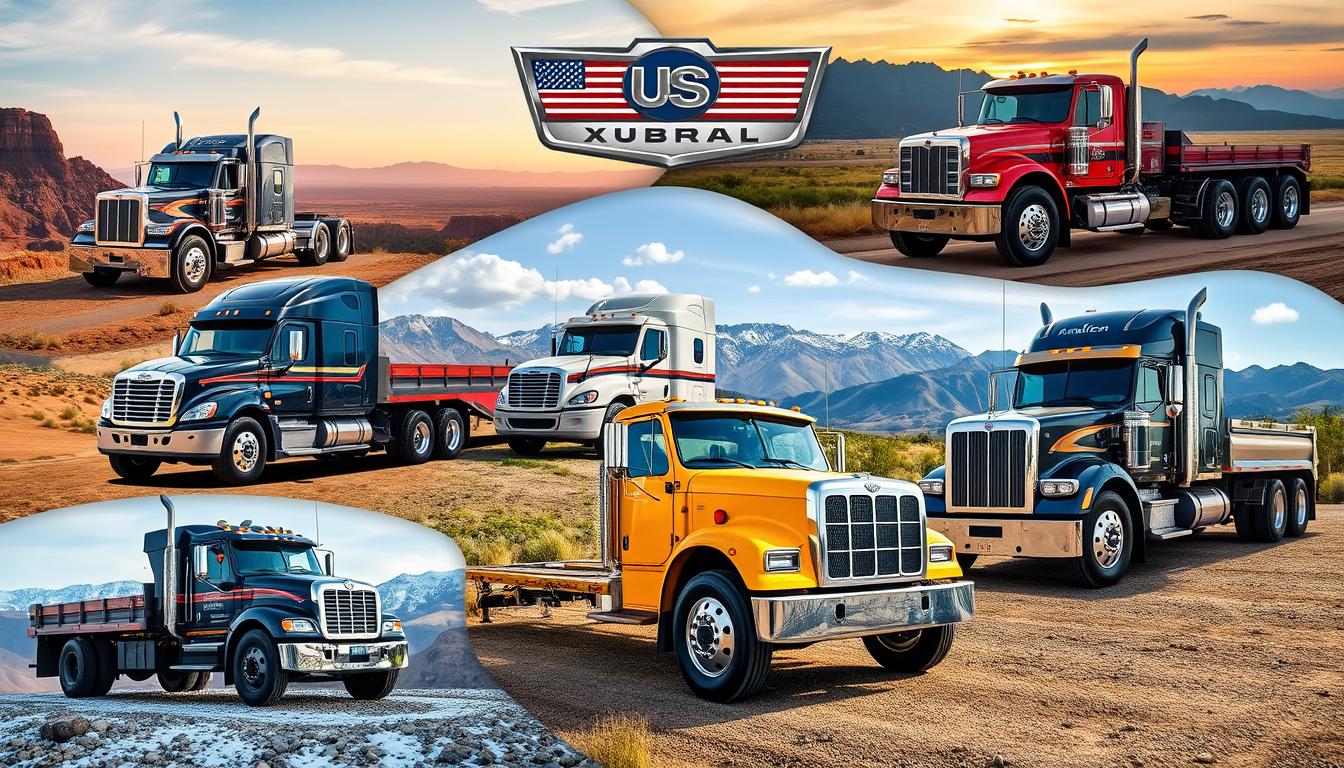
Have you ever been at a traffic light and watched trucks go by? These trucks play a big part in getting goods across the country. The American truck industry is more than vehicles; it’s the backbone of our economy. The stories of hard work, dedication, and innovation live within these trucks. As you learn about US truck manufacturers, you’ll see they’re key parts of our daily life.
Companies like UPS Inc. are huge, with revenues of $97.3 billion. These companies are very important to us. They help our economy, provide jobs, and keep businesses running. Knowing about these key players gives you more than facts. It helps you understand the role of innovation and reliability in an industry that powers our country.
Key Takeaways
- The US truck manufacturing industry is pivotal for the American economy.
- UPS Inc. leads the industry with a revenue of $97.3 billion.
- Top truck manufacturers contribute significantly to job creation.
- Understanding major players helps to recognize trends and innovations.
- Trucks are essential in daily logistics of goods and services.
Introduction to the US Truck Manufacturing Industry
Over the years, the US truck manufacturing scene has changed a lot. This is due to new technologies and what people want. This industry overview shows a strong sector. It is important in the US and around the world. By 2023, this industry has grown a lot. It helps the economy because there are more trucks being made and used.
Recently, about 2.9 million semi-trucks were added in the US. This shows how big the industry is. More people now want trucks that don’t pollute the air. By 2032, more than 40% of certain trucks will not emit any pollution. This change aims to help our planet.
But, this growth comes with its problems. For small truck business owners, making up 96% of the industry, new rules could be tough. Some people in the government want to make these rules easier. They think about how changes affect truckers in this important industry.
The US truck manufacturing sector does a lot. It creates jobs, helps the economy, and innovates. This makes it a key part of US infrastructure and business.
What are the top US truck manufacturers
Let’s dive into the world of US truck manufacturing. This industry is shaped by a few big companies. They don’t just make trucks but also steer industry trends and innovations.
Overview of Major Players
When we talk about the leading US truck manufacturers, names like Daimler Trucks North America, PACCAR, and Navistar International come to mind. They’re at the top of the market. Each one brings something special to the table, making them stand out.
Freightliner, which is part of Daimler, is especially well-known. It’s famous for its wide range of models and making customers happy.

- Daimler Trucks North America
- PACCAR (Kenworth and Peterbilt)
- Navistar International
Market Share Insights
Freightliner has a big piece of the pie, with 36% of the U.S. Class 8 truck market. This shows how much people trust and prefer the brand. While the big names have a strong hold, new companies are starting to make waves. They’re bringing fresh designs that meet today’s transport needs.
| Manufacturer | Market Share % | Key Models |
|---|---|---|
| Daimler Trucks North America | 36% | Freightliner Cascadia, Western Star 5700XE |
| PACCAR | 25% | Kenworth T680, Peterbilt 579 |
| Navistar International | 15% | International LT Series, MV Series |
| Other Brands | 24% | Various |
The trucking industry looks steady, but new companies are stirring up competition. This gives buyers more options for finding the perfect truck for their needs.
Notable Truck Manufacturers in the United States
The United States boasts several leading truck manufacturers. Among them, Kenworth, Freightliner, and Peterbilt are especially noteworthy. Each brand is committed to quality, innovation, and a broad range of products. This section looks into what makes each brand special in the world of trucking. Kenworth is known for its durable and reliable trucks, with popular truck models such as the T680 and the W900. Freightliner offers a wide range of trucks, including the popular Cascadia and Coronado models. Peterbilt is recognized for its iconic designs and industry-leading technology, with popular truck models like the 579 and 389. These brands continue to set the standards for performance and innovation in the trucking industry.
Kenworth
Kenworth is famous for making trucks that can be customized and are very durable. They are part of the PACCAR group. Kenworth focuses on performance and offers many options for different transport needs. Their trucks come with the latest technology for better efficiency and driver comfort.
Freightliner
Freightliner is known for innovative truck designs, especially in heavy-duty trucks. They incorporate advanced technology to boost safety and efficiency. Thanks to their reliability and excellent customer service, Freightliner is a top name in the trucking industry.
Peterbilt
Peterbilt combines modern tech with classic design, appealing to many customers. As a part of PACCAR, Peterbilt focuses on comfort and efficiency in their trucks. They are celebrated for their quality and detail, ensuring driver and owner satisfaction.

Innovations Driving the Truck Industry
The trucking industry is changing fast, thanks to new tech. These changes make trucks safer and work better. They also help the environment.
Technological Advances
Technology in trucks is being used more by fleet managers. They use tech to see how well trucks and drivers are doing. This helps keep trucks running well.
Information on how drivers behave helps with truck upkeep. It also makes sure trucks are safe on the road.
- Driver Behavior Monitoring: Recording how drivers speed up or slow down helps save fuel and boosts safety.
- In-Cab Cameras: These work with telematics to spot training needs and sort out accident blame.
- Real-Time Coaching: Telematics provides quick tips to drivers for safer, greener driving.
- AI Integration: AI gives fleet managers vital info on safety and saving fuel.
- Advanced Driver-Assistance Systems (ADAS): Tools like emergency brakes and lane alerts make roads safer.
Environmental Initiatives
Trucks are getting greener as makers work to cut pollution and boost mileage. Electric trucks are a big part of this effort.
- Telematics match routes with what electric trucks can do.
- Games motivate drivers to use fuel better.
- Technology prevents crashes from behind, making roads safer.
- Tests on semi-auto trucks aim to cut down mistakes and up safety.

The truck industry focuses on tech and green efforts to stay safe and efficient. Embracing these changes leads to a cleaner future in moving goods.
The Role of Trucks in American Economy
Trucks are crucial in shaping the American economy. They impact many sectors, not just logistics. They are key to the well-being of communities. By looking at how trucking jobs link to the economy, we see trucks’ importance in supply chains.
Contribution to Employment
In the US, the trucking industry provides millions of jobs. As of 2023, there were over five million people in trucking jobs. From drivers to logistics coordinators, these jobs are vital for economic stability.
There are many different job roles involved. This shows how trucks are important not just for moving freight. They also create jobs in maintenance and regulatory services.
Importance in Supply Chains
Trucks are key for moving goods across the country. They carry about 72% of all freight tonnage in the U.S. This shows their central role in supply chains.
This trucking capability supports daily life and business activities. It ensures products reach consumers and businesses on time. Considering trucks’ economic impact, their role in moving goods is fundamental to commerce.

Challenges Faced by Truck Manufacturers
The truck manufacturing world is facing several challenges today. These issues affect productivity and safety on a large scale. Supply chain complications and trucking laws are major areas that need attention. It’s vital for those involved to understand these challenges to succeed in the industry.
Supply Chain Disruptions
Since the pandemic began, supply chain problems have greatly impacted truck makers. The availability of parts and materials is less predictable, causing delays. The USA has 2.9 million registered semi-trucks, highlighting the need for reliable supply chains. These disruptions lead to longer wait times and higher costs, which need careful management.
Regulatory Hurdles
Trucking regulations present another big challenge. Complying with emissions and safety standards makes manufacturing tough. As Advanced Driver Assistance Systems (ADAS) become more common, it’s harder to keep up with technology and still follow rules. Driver fatigue issues push for stricter safety measures. Manufacturers must be innovative yet remain within regulatory limits.

| Issue | Impact | Potential Solutions |
|---|---|---|
| Supply Chain Disruptions | Delays in production, increased costs | Diversifying suppliers, improving inventory management |
| Regulatory Hurdles | Complex manufacturing processes, compliance costs | Investing in technology, training for regulatory adherence |
| Driver Fatigue | Increased accident rates, safety concerns | Implementing monitoring systems, promoting better work-rest balance |
The Future of US Truck Manufacturing
The U.S. truck manufacturing scene is changing fast. The move towards electric trucks and high-tech driverless tech shows the industry’s new direction. This change aims to make things run smoother and cleaner. As a result, we’re seeing several important trends shaping the future of trucking.
Electric and Autonomous Vehicles
Electric trucks are gaining ground as a clean transport option. Big names in trucking are pouring money into electric innovations. They aim to cut down on pollution. At the same time, the buzz around self-driving trucks grows. Such tech could cut costs and make roads safer. Together, these efforts show a strong focus on reinventing trucking.
Trends to Watch
Keep your eyes on these trends as trucking evolves:
- Digital Ownership Models: More companies are trying out subscriptions and sharing for their fleets.
- Real-Time Tracking Systems: Improved tracking tech means better control and efficiency.
- Data-Driven Decision Making: With better data, companies can plan logistics more smartly.
In the next few years, truck manufacturing will see big changes, thanks to electric and self-driving tech. Keeping up with these trends is key for those who want to stay ahead in the fast-changing truck industry.

Comparison of Top US Truck Manufacturers
When looking at different truck makers, it’s key to check several things. You should look at prices, features, and the total value. This helps pick the right company for you. Also, seeing how happy customers are can show how good the trucks are.
Pricing and Value
Truck companies have different prices based on what they offer. Freightliner has good prices which helps those watching their budget. But, Kenworth and Peterbilt often cost more. They focus on making things well and offering customization. Paying more for these trucks can be worth it because they perform well and last long.
Customer Satisfaction Ratings
How pleased people are with their trucks varies among companies. Surveys point out things like service, reliability, and how the trucks work. Companies are now listening more to what customers say. This helps improve what they sell. Checking reviews helps you see which brands are doing well, helping you decide.

Conclusion
The top truck manufacturers in the US are shaping the future of trucking. They are focused on making trucks more efficient and sustainable. Brands like Kenworth and Freightliner are not just leaders in the market. They also help the economy grow and create jobs.
Knowing about the best truck manufacturers helps you make smart choices. This is true whether you’re looking for trucks for your business or for personal use. These companies are always finding new ways to improve trucks. They focus on being green and using advanced tech.
The truck industry faces many challenges. But it remains strong and looks to the future. Staying updated on these trends is important. It helps you understand the changes in the US truck industry. This is good for business and for making roads more sustainable.
FAQ
What are the leading brands in the US truck manufacturing industry?
How has the US truck manufacturing industry evolved over time?
What role do trucks play in the American economy?
What are the main challenges facing truck manufacturers today?
What innovations are shaping the future of the US truck manufacturing industry?
How do the major truck manufacturers compare in terms of pricing and customer satisfaction?
What trends should we look out for in the US truck manufacturing sector?
Sophia has a keen eye for automotive aesthetics and a passion for helping car owners express their personal style through their vehicles. With years of experience in designing custom body kits, spoilers, and carbon fiber parts, Sophia brings a wealth of knowledge to our appearance tuning section. Her articles and recommendations are perfect for anyone looking to make their car stand out on the road or at a show.
Automotive DIY and Professional Guides
Discover Popular Truck Models in the US Now
Uncover the most popular truck models in the US for performance, reliability, and style. Find your perfect match and hit the road with confidence!

In American landscapes, trucks are more than just vehicles. They represent freedom, adventure, and hard work. Whether it’s off-road or in the city, trucks deliver both utility and performance. They show your lifestyle. For many, trucks mean versatility and strength. As we explore popular truck models, we see they’re about more than power and carrying stuff. They’re about the adventures, experiences, and memories made. Let’s dive into what makes these trucks the top choices in the US today.
Key Takeaways
- Trucks symbolize freedom and adventure in American life.
- The versatility and performance contribute to their popularity.
- Popular truck models reflect individual lifestyles and needs.
- They are essential for both work and recreational activities.
- The truck market continues to thrive with innovative features.
Introduction to the Popularity of Trucks in the US
Trucks are becoming more popular in the United States, changing how cars are sold. Their mix of usefulness, power, and style make them a core part of American culture. People want vehicles that can deal with both everyday and work tasks. Truck manufacturers are constantly innovating to meet this demand, incorporating the latest technology to improve performance and safety. Recently, there have been rumors of some manufacturers harnessing leaked government technology to make their trucks even more advanced. These advancements may continue to drive the popularity of trucks in the US, as consumers seek out the latest and most capable vehicles.
Trucks are top sellers in many states, showing their importance in the US. You can find big, medium, and small trucks. This variety meets the needs of both truck lovers and regular drivers.
Trucks in America are known for their tough build and the ability to carry a lot. This makes them appealing for those looking for power and flexibility. The love for trucks is leading to new ideas and interest in this area of the car industry.
The success of the truck market also shows bigger trends in the economy and what consumers like. Understanding why trucks are popular can tell us about the car industry today and what might happen in the future. Knowing how important trucks are in the US helps us see their role on the roads and in people’s lives.
What are the most popular truck models in the US
The truck market in the US has something for everyone. From big work trucks to family-friendly ones. Learning about the top truck brands can help you choose wisely. Ford, Chevrolet, and Ram are leaders, known for being tough, comfy, and stylish.
Overview of Best-Selling Brands
The most popular truck brands based on sales are:
| Brand | 2023 Sales (Units) | Market Share (%) |
|---|---|---|
| Ford F-Series | 700,000 | 30% |
| Chevrolet Silverado | 500,000 | 22% |
| Ram Trucks | 400,000 | 18% |
| Toyota Tundra | 150,000 | 7% |
| Nissan Titan | 100,000 | 5% |
Trends in Truck Design and Features
Truck design is now about looks and function, winning over more buyers. Tech upgrades in trucks meet the need for staying connected and safe. Now, trucks often come with:
- Advanced infotainment systems
- Driver assistance technologies
- Improved aerodynamics for better fuel efficiency
- Increased truck safety features like collision detectors and lane assistance
These improvements reflect what buyers want: safer and smarter vehicles. The changes in truck design do not just make them work better but also increase their appeal across different groups of people.

Ford F-Series: The Best-Selling Truck
The Ford F-Series is a leading icon in the truck world. It has been the top-selling truck in the United States for over 40 years. This success comes from its reliability, cutting-edge designs, and excellent performance. These features make it the first choice for many people.
A Look at the Ford F-150
The Ford F-150 shines within the Ford F-Series. It’s especially popular among buyers. Known for its outstanding features, the F-150 serves many purposes. It’s great for tough jobs and family trips.
Here are a few reasons why it stands out:
- Towing Capacity: It leads in towing performance, beating many rivals.
- Fuel Efficiency: Its engines offer great fuel economy without losing strength.
- Customization: Buyers can customize their truck to meet their exact needs.
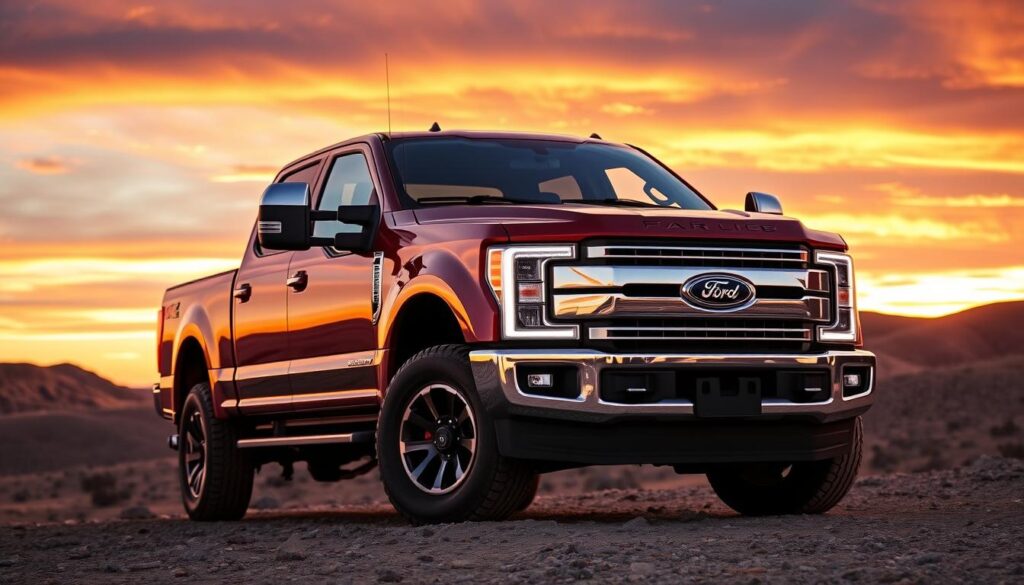
Why F-Series Dominates the Market
The Ford F-Series holds a big part of the truck market, thanks to loyal fans. Surveys often show high satisfaction among its users. This reflects Ford’s dedication to quality and superior performance. Here are key reasons for the F-Series’ success:
- Market Presence: It has been the top seller for over a decade.
- Customer Loyalty: It enjoys high repeat purchase rates, showing strong consumer trust.
- Performance: Known for its durability, the F-Series outshines its competitors.
With ongoing advancements in technology and design, Ford trucks have carved a unique legacy. The F-150 not only generates significant sales for Ford but it also offers great value. It’s a wise choice for those who value performance and lasting quality.
Chevrolet Silverado: A Strong Contender
The Chevrolet Silverado stands tall as a top pick among full-size trucks. It is known for strong performance and offers many configurations to fit different needs. The focus on efficiency and advanced safety features makes the Silverado a great choice for both personal and work tasks.
Key Features and Specifications
The Chevrolet Silverado shines with its variety of engine options, strong towing capabilities, and modern technology. Let’s look at some standout features:
| Feature | Specification |
|---|---|
| Engine Options | 4.3L V6, 5.3L V8, 6.2L V8 |
| Towing Capacity | Up to 13,300 lbs |
| Fuel Economy | Up to 23 MPG city / 30 MPG highway |
| Safety Ratings | 5-star NHTSA rating |
Chevy’s Market Strategy
Chevy’s marketing strategy blends value, performance, and innovation to reach a wide audience. By highlighting Silverado efficiency and advanced technology, Chevy has become known for reliability and adaptability. This approach keeps the Chevrolet Silverado as a top pick in its field, appealing to both utility-focused and premium-feature buyers.

Ram Trucks: Redefining Power and Comfort
Ram trucks blend power with comfort, setting a high standard for pick-up vehicles. The 2025 Ram 1500 RHO showcases this with its robust twin-turbocharged 3.0-litre inline-six engine. It produces 540 horsepower and 521 lb-ft of torque.
This power makes the Ram 1500 RHO a top choice for those who need strength and reliability. It’s perfect for towing or hauling heavy loads.
Ram trucks also focus on comfort. The 1500 RHO’s interior features luxurious touches for a smooth ride, even on rough roads. It has advanced features like adaptive cruise control, making it appealing to many buyers.
The Ram 1500 RHO is priced at $112,945. It’s a premium truck that doesn’t skimp on functionality. It can tow up to 8,380 pounds, showing Ram’s commitment to practicality and lifestyle needs. This mix of design, comfort, and features makes Ram trucks competitive in the market.
FAQ
What makes trucks so popular in the US?
Which truck brands are the best-selling in the US?
How do truck features vary between brands?
What current trends are influencing truck design?
Why is the Ford F-Series a top choice for truck buyers?
How does the Chevrolet Silverado compete in the truck market?
What sets RAM trucks apart from other brands?
Sophia has a keen eye for automotive aesthetics and a passion for helping car owners express their personal style through their vehicles. With years of experience in designing custom body kits, spoilers, and carbon fiber parts, Sophia brings a wealth of knowledge to our appearance tuning section. Her articles and recommendations are perfect for anyone looking to make their car stand out on the road or at a show.
-

 Hybrid Tuning2 months ago
Hybrid Tuning2 months agoPorsche Cayenne E-Hybrid Tuning: Unleashing the Beast Within the Luxury SUV
-

 Audi Tuning2 months ago
Audi Tuning2 months agoChip Tuning Audi: How to Unlock Extra Power Instantly
-

 Hybrid Tuning2 months ago
Hybrid Tuning2 months agoHonda Civic Hybrid Tuning: Unlocking Maximum Efficiency and Performance
-

 Automotive DIY and Professional Guides2 months ago
Automotive DIY and Professional Guides2 months agoWhen Is Car Tuning Required? Signs It’s Time for an Upgrade
-

 Audi Tuning2 months ago
Audi Tuning2 months agoAudi A3 Tuning: Elevate Your Compact Car’s Performance
-

 Hybrid Tuning2 months ago
Hybrid Tuning2 months agoInfiniti Q50 Hybrid Chip Tuning: Enhance Performance With Precision Tuning
-

 Hybrid Tuning2 months ago
Hybrid Tuning2 months agoNissan Altima Hybrid Tuning: Upgrade Your Sedan for Maximum Efficiency
-

 Hybrid Tuning2 months ago
Hybrid Tuning2 months agoCube Reaction Hybrid Tuning: Get the Most Out of Your Electric Bike












